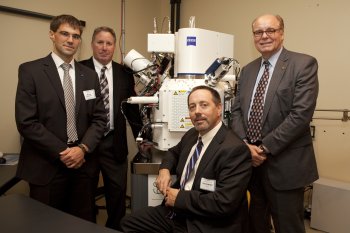Carl Zeiss Microscopy, a company of the Carl Zeiss Group and leading provider of light, laser-scanning and electron and ion beam microscopes, today announced the celebration of its tenth anniversary of the AURIGA CrossBeam FIB-SEM technology.
In honor of the AURIGA's tenth anniversary, a ceremony was held at the Center for Composite Materials at the University of Delaware. The system is the first major acquisition intended for the University´s new Interdisciplinary Science and Engineering Laboratory (ISE Lab) now under construction.

When completed, the ISE Lab will house their new AURIGA 60 CrossBeam FIB-SEM instrument and provide nearly 200,000 square feet of space for hands on research and education. According to Dr. David Martin, Chair of Materials Science and Engineering, "This multipurpose analytical instrument is an excellent demonstration of the interdisciplinary research opportunities that will be provided by the ISE Lab. The microscope will be open to use by all members of the University of Delaware community, as well as our partners in industry, government laboratories and neighboring academic institutions."
"The versatile, flexible AURIGA CrossBeam system has become the most successful FIB-SEM instrument ever produced by Carl Zeiss," said Michael Rauscher, Director of the Product Segment CrossBeam. "We are proud of our accomplishments, and we are proud of the fact that the University of Delaware has chosen to equip its laboratories with the AURIGA CrossBeam FIB-SEM technology and to help us celebrate the tenth anniversary of this pioneering product."
Referred to by some people as the Swiss army knife of microscopy tools, the AURIGA instrument includes both a GEMINI scanning electron microscope (SEM) column and a focused ion beam (FIB) column. The SEM column enables the AURIGA to create superb, high resolution, nano scale images, while the FIB column enables the tool to remove material from the sample by milling or cutting. In fact, the AURIGA can also add material to the sample by means of chemical vapor deposition. Moreover, by automatically combining several images, a complete 3D-model of the sample can be created.
As a result of these capabilities, the AURIGA is ideally suited for today's materials research that involves a great complexity of tasks including chemical composition analysis, crystallographic orientation, complete morphology, and electrical attributes; additionally, it is also superbly suited for life science research applications.
Some of today's most demanding applications being handled by the AURIGA include:
- analysis of hydrocarbon deposits in shale rock
- 3D brain mapping and reconstruction
- large area imaging
- and more.